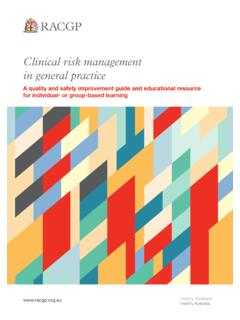Transcription of American National Standard for Occupational and ...
1 A N S I / I S E A American National Standard for Occupational and educational Personal Eye and Face Protection Devices ANSI/ISEA Revision of ANSI American National Standard Occupational and educational Personal Eye and Face Protection Devices Secretariat International Safety Equipment Association Approved April 13, 2010 American National Standards Institute, Inc. American National Standard An American National Standard implies a consensus of those substantially concerned with its scope and provisions.
2 An American National Standard is intended as a guide to aid the manufac-turer, the consumer, and the general public. The existence of an American National Standard does not in any respect preclude anyone, whether they have approved the Standard or not, from manu-facturing, marketing, purchasing, or using products, processes, or procedures not conforming to the Standard . American National Standards are subject to periodic review and users are cautioned to obtain the latest editions. The American National Standards Institute does not develop standards and will in no circums-tances give an interpretation of any American National Standard .
3 Moreover, no persons shall have the right or authority to issue an interpretation of an American National Standard in the name of the American National Standards Institute. CAUTION NOTICE: This American National Standard may be revised or withdrawn at any time. The procedures of the American National Standards Institute require that action be taken to reaf-firm, revise, or withdraw this Standard no later than five years from the date of publication. Pur-chasers of American National Standards may receive current information on all standards by call-ing or writing the American National Standards Institute.
4 Published by International Safety Equipment Association 1901 North Moore Street, Suite 808, Arlington, Virginia 22209 USA Copyright 2010 by ISEA All rights reserved. No part of this publication (with the exception of Annex I, Selection Chart) may be reproduced in any form, in an elec-tronic retrieval system or otherwise, without the prior written permission of the publisher. Printed in the United States of America Foreword (This Foreword is not a part of ANSI/ISEA ) The first version of a document that could be termed a Standard dates back to 1922 with the first edition of the Z2 Standard for head and eye protection.
5 This Standard originated from the cooperative work by the War and Navy Departments and the National Bureau of Standards. Throughout the 1930 s and 1940 s the Z2 Standard for eye and face protection was published as part of the initial 1938 National Bureau of Standards Handbook H24 that also included standards for respiratory and head protection. The 1946 revision was the first to recognize advances in materials technology and in-cluded criteria for materials other than glass. In 1959, Z2 was approved as the American Standard Safety Code for Head, Eye and Respiratory Protection.
6 In 1961 the Standards Safety Board split the Z2 project into three separate standards. Z87 for Eye and Face Protection, Z88 for Respiratory Protection and Z89 for head protection. On September 18, 1968 the eye and face protection Standard was published with the Z87 designation, Since then has been revised in 1979, 1989, and 2003. This edition of represents a dramatic change in the way the Standard is organized and how users of eye and face protectors will utilize the Standard for selecting products for specific hazards.
7 The 2003 edi-tion of the Standard and its predecessors were organized by the type of protector. Each type of pro-tector, spectacles, goggles, faceshields and welding helmets had a chapter in the Standard . The chapter de-scribed the protector, the required testing and optical properties and established product marking require-ments. This led to significant repetition within the Standard as some products have the same testing, optical and marking requirements. In the process of revising , the Z87 Accredited Standards Committee (ASC) evaluated user needs, product variety and protection in an effort to write a document that is more useful for eye and face protection wearers.
8 This 2010 edition is the product of work on behalf of the Z87 committee to develop a Standard that focuses on the hazard and is organized by the nature of the hazard such as droplet and splash, impact, optical radiation, dust, fine dust and mist. A benefit of this hazard approach to the Standard is that it will encourage users and employers to evaluate the specific hazards that they are exposed to in their environment. Selection of appropriate eye and face protection will be based on this hazard evaluation. Because the Standard is radically different, the product markings have changed.
9 Users will need to be educated on matching the hazard that they need protection from with the marking on the product. The Z87 ASC also made efforts to parallel other eye and face pro-tection standards used in the world. Many of the tables in this Standard reflect this effort to harmonize with global standards. Suggestions for improvement of this Standard are welcome. They should be sent to the International Safety Equipment Association, 1901 N. Moore Street, Suite 808, Arlington, VA 22209, This Standard was processed and approved for submittal to ANSI by the Accredited Standards Committee on Safety Standards for Eye Protection, Z87.
10 Committee approval of the Standard does not necessarily imp-ly that all committee members voted for its approval. At the time it approved this Standard , the Z87 Com-mittee had the following members: Daniel Torgersen, Chairman Jack B. Hirschmann, Jr., Vice-Chairman Organization Represented Name of Representative American Optometric Association Gregory Good, , Neil Hodur, American Society of Safety Engineers Jack B. Hirschmann, Jr. American Welding Society Philip M.



